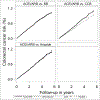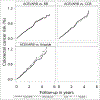Renin-Angiotensin-Aldosterone System-based Antihypertensive Agents and the Risk of Colorectal Cancer Among Medicare Beneficiaries
- PMID: 31348009
- PMCID: PMC6768762
- DOI: 10.1097/EDE.0000000000001065
Renin-Angiotensin-Aldosterone System-based Antihypertensive Agents and the Risk of Colorectal Cancer Among Medicare Beneficiaries
Abstract
Background: Biologic evidence suggests that angiotensin II may play a role in tumor progression or growth. We compared the short-term colorectal cancer (CRC) risk among initiators of angiotensin-converting enzyme inhibitors (ACEI) or angiotensin receptor blockers (ARB) versus guideline-recommended clinical alternatives (beta blockers, calcium channel blockers [CCB], and thiazides).
Methods: We conducted a new-user cohort study on U.S. Medicare beneficiaries aged over 65 years, who initiated antihypertensive monotherapy during 2007-2013 and were free of cancer diagnosis before drug initiation. Follow-up began 6 months postinitiation to allow time for the diagnostic delay. We estimated hazard ratios (HR) with 95% confidence intervals (CI) using propensity score weighted Cox regression, overall and stratified by time since drug initiation, and 5-year cumulative risk differences (RD) using Kaplan-Meier estimator. We assessed the potential for unmeasured confounding using supplemental data from Medicare Current Beneficiary Survey.
Results: For analyses without censoring for treatment changes, we observed 532 CRC events among 111,533 ACEI/ARB initiators. After a median follow-up of 2.2 years (interquartile range: 1.0-3.7), CRC risk was similar between ACEI/ARB and active comparators, with adjusted HRs of 1.0 (95% CI = 0.85, 1.1) for ACEI/ARB versus beta blockers, 1.2 (95% CI = 0.97, 1.4) for ACEI/ARB versus CCB and 1.0 (95% CI = 0.80, 1.3) for ACEI/ARB versus thiazide. Five-year RDs and as-treated analyses, which censored follow-up at medication changes, produced similar findings.
Conclusions: Based on real-world antihypertensive utilization patterns in Medicare beneficiaries, our study suggests no association between ACEI/ARB initiation and the short-term CRC risk.
Conflict of interest statement
Conflicts of interest:
P.T.H has no conflicts of interest. T.S. reports salary support from Center for Pharmacoepidemiology in the Department of Epidemiology, Gillings School of Global Public Health (current members: GlaxoSmithKline, UCB BioSciences, Merck), research support from AstraZeneca, Amgen, and ownership interest in Novartis, Roche, BASF, AstraZeneca, Johnson & Johnson, and Novo Nordisk.
R.J.S. is a paid consultant to Amgen, Pfizer and Merck.
Figures


Similar articles
-
Association of Race/Ethnicity-Specific Changes in Antihypertensive Medication Classes Initiated Among Medicare Beneficiaries With the Eighth Joint National Committee Panel Member Report.JAMA Netw Open. 2020 Nov 2;3(11):e2025127. doi: 10.1001/jamanetworkopen.2020.25127. JAMA Netw Open. 2020. PMID: 33206191 Free PMC article.
-
Renin-angiotensin-aldosterone system inhibitors and SARS-CoV-2 infection: an analysis from the veteran's affairs healthcare system.Am Heart J. 2021 Oct;240:46-57. doi: 10.1016/j.ahj.2021.06.004. Epub 2021 Jun 12. Am Heart J. 2021. PMID: 34126079 Free PMC article.
-
Comparative Effectiveness of Renin-Angiotensin System Inhibitors and Calcium Channel Blockers in Individuals With Advanced CKD: A Nationwide Observational Cohort Study.Am J Kidney Dis. 2021 May;77(5):719-729.e1. doi: 10.1053/j.ajkd.2020.10.006. Epub 2020 Nov 24. Am J Kidney Dis. 2021. PMID: 33246024
-
Real-World Effectiveness of Beta-Blockers versus Other Antihypertensives in Reducing All-Cause Mortality and Cardiovascular Events.Int J Clin Pract. 2022 Jul 30;2022:6124559. doi: 10.1155/2022/6124559. eCollection 2022. Int J Clin Pract. 2022. PMID: 35989866 Free PMC article. Review.
-
Role of antihypertensive therapy with angiotensin-converting enzyme inhibitors or angiotensin II receptor blockers in combination with calcium channel blockers for stroke prevention.J Am Pharm Assoc (2003). 2010 Sep-Oct;50(5):e116-25. doi: 10.1331/JAPhA.2010.09234. J Am Pharm Assoc (2003). 2010. PMID: 20833609 Review.
Cited by
-
The effects of gastrodin injection on hypertension: A systematic review and meta-analysis.Medicine (Baltimore). 2020 Jul 2;99(27):e20936. doi: 10.1097/MD.0000000000020936. Medicine (Baltimore). 2020. PMID: 32629695 Free PMC article.
-
Association Between Angiotensin II Receptor Blockers and the Risk of Lung Cancer Among Patients With Hypertension From the Korean National Health Insurance Service-National Health Screening Cohort.J Prev Med Public Health. 2020 Dec;53(6):476-486. doi: 10.3961/jpmph.20.405. Epub 2020 Nov 3. J Prev Med Public Health. 2020. PMID: 33296588 Free PMC article.
-
Long-term use of antihypertensive medications, hypertension and colorectal cancer risk and mortality: a prospective cohort study.Br J Cancer. 2022 Nov;127(11):1974-1982. doi: 10.1038/s41416-022-01975-4. Epub 2022 Sep 22. Br J Cancer. 2022. PMID: 36138074 Free PMC article.
-
Use of sensitivity analyses to assess uncontrolled confounding from unmeasured variables in observational, active comparator pharmacoepidemiologic studies: a systematic review.Am J Epidemiol. 2025 Feb 5;194(2):524-535. doi: 10.1093/aje/kwae234. Am J Epidemiol. 2025. PMID: 39098826 Free PMC article.
-
Impact of Polypharmacy for Chronic Ailments in Colon Cancer Patients: A Review Focused on Drug Repurposing.Cancers (Basel). 2020 Sep 23;12(10):2724. doi: 10.3390/cancers12102724. Cancers (Basel). 2020. PMID: 32977434 Free PMC article. Review.
References
-
- Nelson DL, Lehninger AL, Cox MM. Lehninger principles of biochemistry. New York: W.H. Freeman; 2005.
-
- Fernandez LA, Twickler J, Mead A. Neovascularization produced by angiotensin II. J Lab Clin Med. 1985;105(2):141–145. - PubMed
-
- Folkman J, Watson K, Ingber D, Hanahan D. Induction of angiogenesis during the transition from hyperplasia to neoplasia. Nature. 1989;339(6219):58–61. - PubMed
-
- Daemen MJ, Lombardi DM, Bosman FT, Schwartz SM. Angiotensin II induces smooth muscle cell proliferation in the normal and injured rat arterial wall. Circ Res. 1991;68(2):450–456. - PubMed
-
- Chiu T, Santiskulvong C, Rozengurt E. ANG II stimulates PKC-dependent ERK activation, DNA synthesis, and cell division in intestinal epithelial cells. Am J Physiol Gastrointest Liver Physiol. 2003;285(1):G1–11. - PubMed
Publication types
MeSH terms
Substances
Grants and funding
LinkOut - more resources
Full Text Sources
Medical
Miscellaneous

